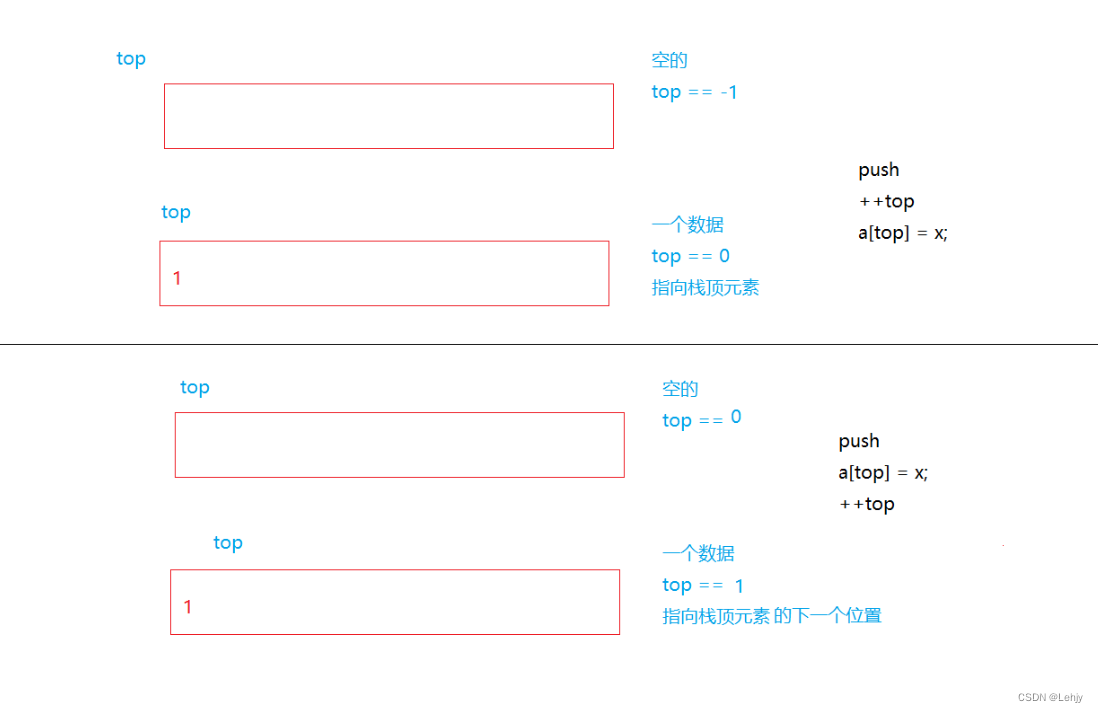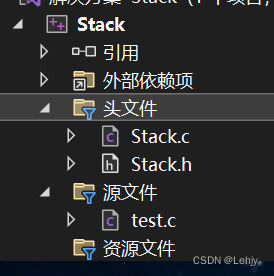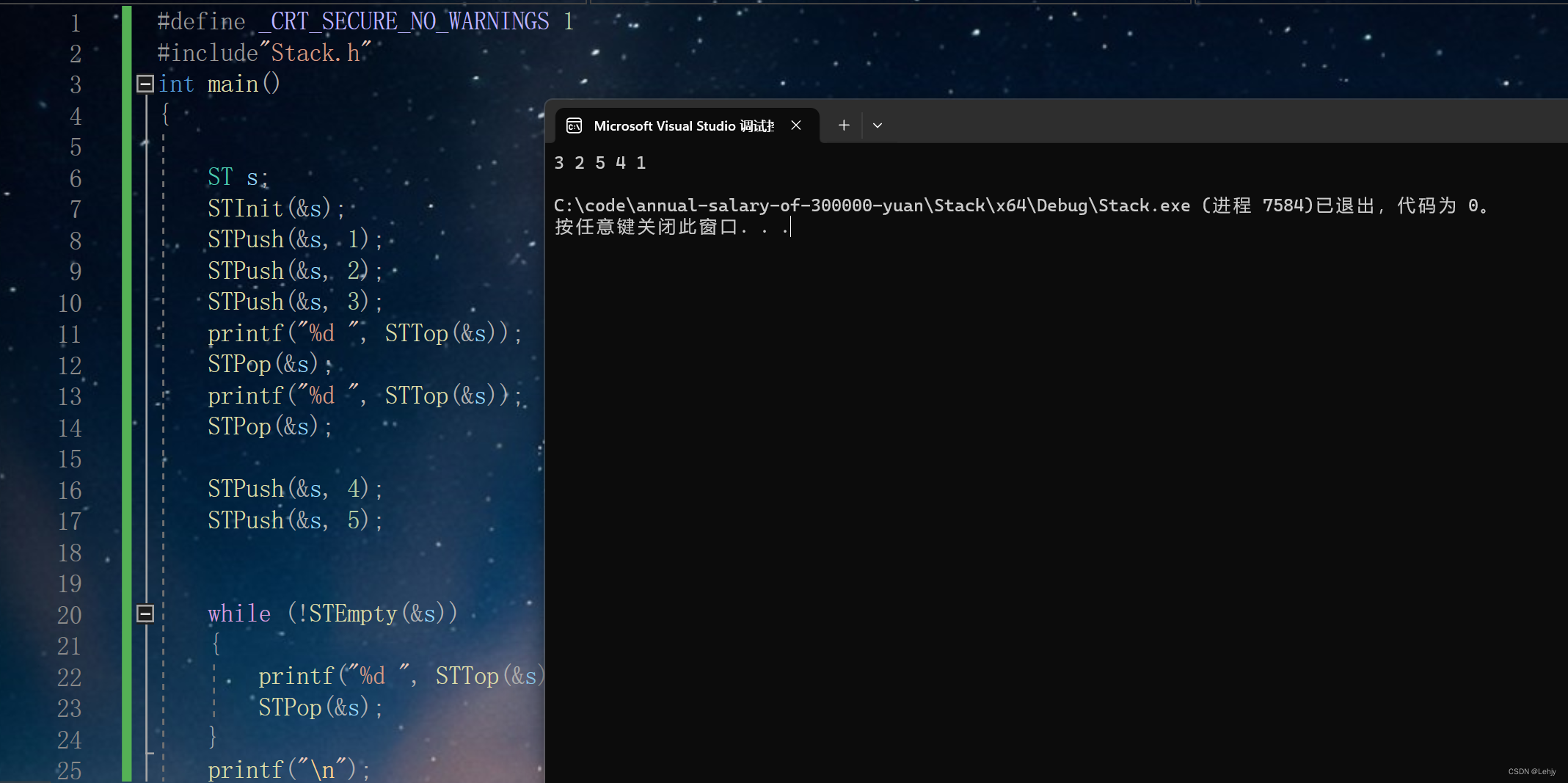前言:各位小伙伴们我们前面已经学习了带头双向循环链表,数据结构中还有一些特殊的线性表,如栈和队列,那么我们今天就来实现数组栈。

目录:
一、
栈的概念
二、
栈的实现
三、
代码测试
栈的概念:
栈的概念及结构
栈:一种特殊的线性表,其只允许在固定的一端进行插入和删除元素操作。进行数据插入和删除操作的一端
称为栈顶,另一端称为栈底。栈中的数据元素遵守后进先出LIFO(Last In First Out)的原则,压栈:栈的插入操作叫做进栈/压栈/入栈,入数据在栈顶,出栈:栈的删除操作叫做出栈。出数据也在栈顶。
栈顶(Top):线性表允许进行插入删除的那一端。
栈底(Bottom):固定的,不允许进行插入和删除的另一端。
空栈:不含任何元素的空表。
栈的实现:
栈的实现一般可以使用数组或者链表实现,相对而言数组的结构实现更优一些。因为数组在尾上插入数据的代价比较小。
接口:
// 初始化栈
void STInit(ST* pst);
// 销毁栈
void STDestroy(ST* pst);
// 入栈
void STPush(ST* pst, STDataType x);
// 出栈
void STPop(ST* pst);
// 获取栈顶元素
STDataType STTop(ST* pst);
// 检测栈是否为空,如果为空返回非零结果,如果不为空返回0
bool STEmpty(ST* pst);
// 获取栈中有效元素个数
int STSize(ST* pst);
这里我们需要三个文件,一个头文件,一个文件用来实现我们的各种接口,一个文件用来测试我们的代码。
头文件(Stack.h):
#pragma once
#include<stdio.h>
#include<assert.h>
#include<stdlib.h>
#include<stdbool.h>
typedef int STDataType;
typedef struct Stack
{
int* a;
int top; // 标识栈顶位置的
int capacity;
}ST;
void STInit(ST* pst);
void STDestroy(ST* pst);
// 栈顶插入删除
void STPush(ST* pst, STDataType x);
void STPop(ST* pst);
STDataType STTop(ST* pst);
bool STEmpty(ST* pst);
int STSize(ST* pst);

我们的top是栈顶,如果我们的top=0时,我们指向的就是栈顶元素,如果我们的top=1,那么我们的top指向的就是栈顶元素的下一个位置。
函数实现(Stack.c)
#include"Stack.h"
void STInit(ST* pst)
{
assert(pst);
pst->a = NULL;
pst->capacity = 0;
pst->top = 0;
}
void STDestroy(ST* pst)
{
}
// 栈顶插入删除
void STPush(ST* pst, STDataType x)
{
assert(pst);
if (pst->top == pst->capacity)
{
int newcapacity = pst->capacity == 0 ? 4 : pst->capacity * 2;
STDataType* tmp = (STDataType*)realloc(pst->a, sizeof(STDataType) * newcapacity);
if (tmp == NULL)
{
perror("realloc fail");
return;
}
pst->a = tmp;
pst->capacity = newcapacity;
}
pst->a[pst->top] = x;
pst->top++;
}
void STPop(ST* pst)
{
assert(pst);
// 不为空
assert(pst->top > 0);
pst->top--;
}
STDataType STTop(ST* pst)
{
assert(pst);
// 不为空
assert(pst->top > 0);
return pst->a[pst->top - 1];
}
bool STEmpty(ST* pst);
int STSize(ST* pst);
测试代码(test.c)
int main()
{
ST s;
STInit(&s);
STPush(&s, 1);
STPush(&s, 2);
STPush(&s, 3);
STPush(&s, 4);
STPush(&s, 5);
while (!STEmpty(&s))
{
printf("%d ", STTop(&s));
STPop(&s);
}
printf("\n");
return 0;
}
我们这里入栈五个数据,当我们的栈里面不为空时,我们就访问栈顶元素,在让栈顶元素出栈。直到我们的栈为空时,就退出循环。
int main()
{
ST s;
STInit(&s);
STPush(&s, 1);
STPush(&s, 2);
STPush(&s, 3);
printf("%d ", STTop(&s));
STPop(&s);
printf("%d ", STTop(&s));
STPop(&s);
STPush(&s, 4);
STPush(&s, 5);
while (!STEmpty(&s))
{
printf("%d ", STTop(&s));
STPop(&s);
}
printf("\n");
return 0;
}
这里我们可以同时入栈和出栈,我们先入栈1,2,3,在出栈,我们的栈是后入先出,也就是说我们后面入栈的元素在出栈的时候先出栈,我们出栈一个也就是3,再出栈就是2,最后入栈就是4,5。




